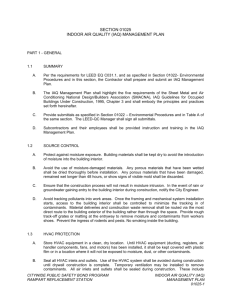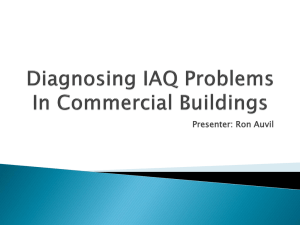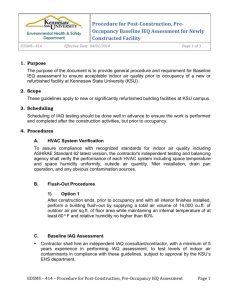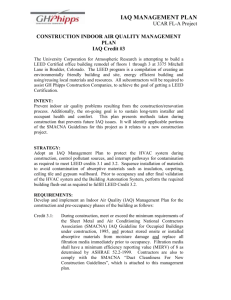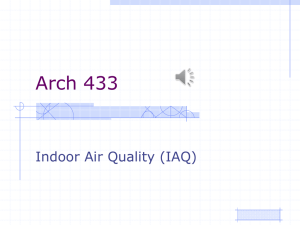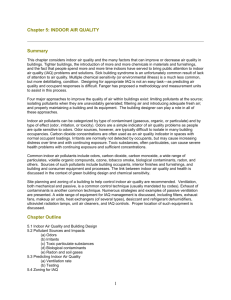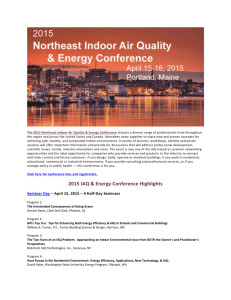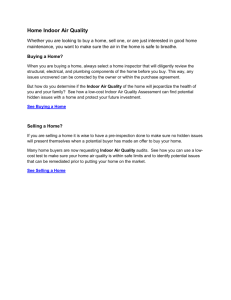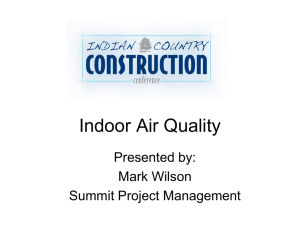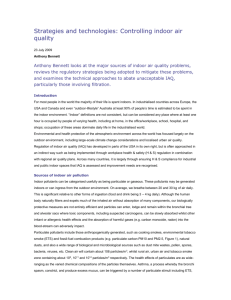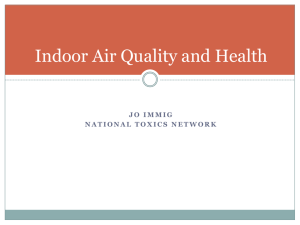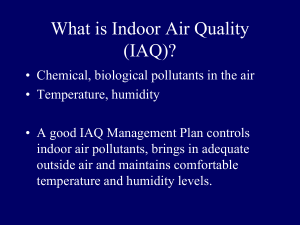S01550 - Nycsca.org
advertisement
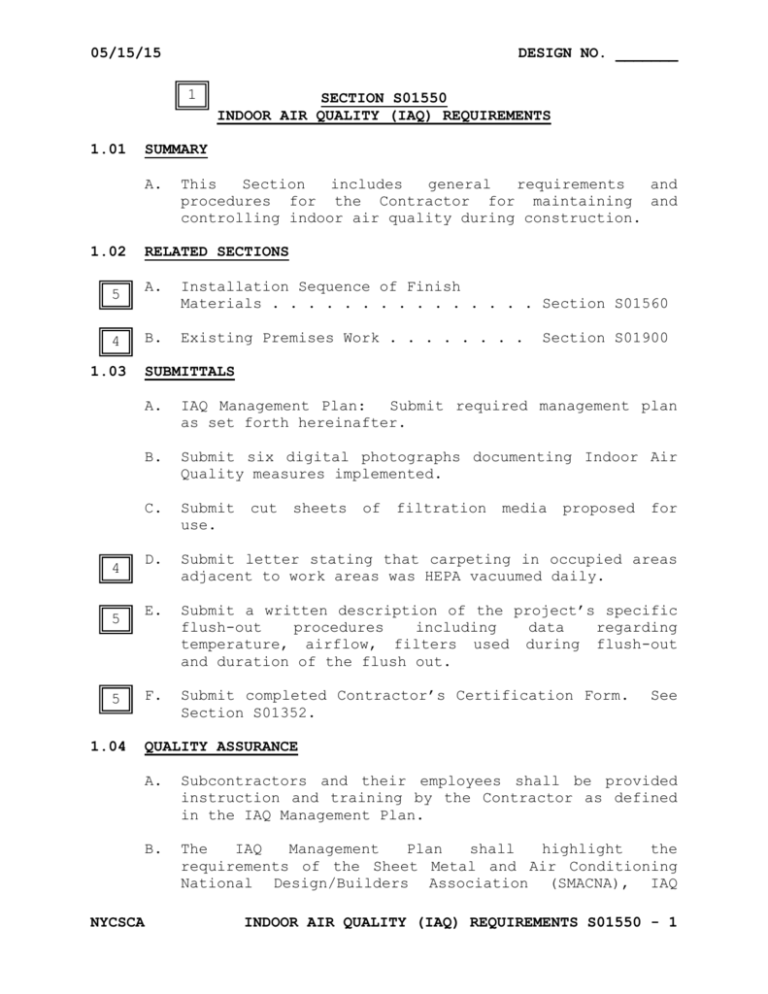
05/15/15 DESIGN NO. _______ 1 1.01 SUMMARY A. 1.02 5 4 1.03 4 5 5 1.04 SECTION S01550 INDOOR AIR QUALITY (IAQ) REQUIREMENTS This Section includes general requirements and procedures for the Contractor for maintaining and controlling indoor air quality during construction. RELATED SECTIONS A. Installation Sequence of Finish Materials . . . . . . . . . . . . . . . Section S01560 B. Existing Premises Work . . . . . . . . Section S01900 SUBMITTALS A. IAQ Management Plan: Submit required management plan as set forth hereinafter. B. Submit six digital photographs documenting Indoor Air Quality measures implemented. C. Submit use. D. Submit letter stating that carpeting in occupied areas adjacent to work areas was HEPA vacuumed daily. E. Submit a written description of the project’s specific flush-out procedures including data regarding temperature, airflow, filters used during flush-out and duration of the flush out. F. Submit completed Contractor’s Certification Form. Section S01352. cut sheets of filtration media proposed for See QUALITY ASSURANCE A. Subcontractors and their employees shall be provided instruction and training by the Contractor as defined in the IAQ Management Plan. B. The IAQ Management Plan shall highlight the requirements of the Sheet Metal and Air Conditioning National Design/Builders Association (SMACNA), IAQ NYCSCA INDOOR AIR QUALITY (IAQ) REQUIREMENTS S01550 - 1 05/15/15 DESIGN NO. _______ Guidelines for Occupied Buildings under Construction, 2nd Addition 2007, ANSI/SMACNA 008-2008 (Chapter 3) and shall include the principles and practices set forth in this Section. 1.05 INDOOR AIR QUALITY MANAGEMENT PLAN A. Contractor’s IAQ Construction Plan shall include procedures to prevent indoor air quality problems resulting from the construction/renovation process in order to help sustain the comfort and well-being of construction workers and building occupants. 1. The Plan shall identify the requirements incorporated from the Sheet Metal and Air Conditioning National Design/Builders Association (SMACNA), IAQ Guidelines for Occupied Buildings under Construction, 2nd Addition 2007, ANSI/SMACNA 008-2008 (Chapter 3). Identify potential contaminant pathways in the plan. 2. Contractor’s detailed plan shall be based on the particular characteristics of the Project, and include the items listed in this Section as a minimum. In addition utilize the following control approaches as applicable for the Project: a. b. c. d. e. f. g. 1.06 Protecting stored items of the HVAC systems Containing the work area; Limit or avoid use of permanent HVAC systems during demolition and construction; Reducing emissions; Intensifying housekeeping; Rescheduling work hours; or Moving occupants. HVAC PROTECTION A. NYCSCA Store HVAC equipment and all parts of the HVAC system in a clean, dry location. Until HVAC equipment and system items (ducting, registers, air handler components, fans, motors, etc) have been installed, they shall be kept covered with plastic film or in a location where it will not be exposed to moisture, dust, or other contaminants. INDOOR AIR QUALITY (IAQ) REQUIREMENTS S01550 - 2 05/15/15 DESIGN NO. _______ B. Seal all HVAC inlets and outlets. Use of the HVAC system shall be avoided during construction until drywall construction is complete. Temporary ventilation may be installed to remove contaminants. All air inlets and outlets shall be sealed during construction. These include outside air inlets, grilles, diffusers, supply ducts, return ducts, ceiling plenums, VAV (variable-air volume) plenum intakes, and window ventilator or air conditioning units. Openings shall be sealed with plastic film and tape that can be removed cleanly. C. Seal HVAC components during installation. For ducting runs that require several days to install, sections shall be sealed off as they are completed. Seals shall be removed prior to continuing the ducting run. Other components of the HVAC system shall be subjected to the same requirements to protect them from contamination. D. Use temporary filtration media. If the HVAC system is to be used while construction work is being done, temporary filtration media shall be installed at each return grill. Such filtration media shall have a minimum filtration efficiency (Minimum Efficiency Reporting Value-MERV per ASHRAE 52.2) of 8. After Substantial Completion use new filtration with a MERV rating of 13 in areas of the work where dust producing activities are generated. E. Inspect filters regularly. When the HVAC system is being used during construction and temporary filters are installed, filters shall be inspected weekly and replaced as needed. F. When outdoor construction activities generate dust, combustion emissions, or other contaminants, operable windows and outside air supplies to enclosed portions of the building shall be protected in a manner that prevent contaminants from entering the building without harming the equipment. 1.07 SOURCE CONTROL A. NYCSCA Protect against moisture exposure. Building materials should be kept dry with special care taken with materials susceptible to the growth of mold and INDOOR AIR QUALITY (IAQ) REQUIREMENTS S01550 - 3 05/15/15 DESIGN NO. _______ bacteria such as wood, porous insulation, paper, and fabric. Schedule deliveries so that materials that are susceptible to mold growth are installed after the enclosure is watertight. Cover building materials to prevent rain damage, and if resting on the ground, use spacers to allow air to circulate between the ground and the materials. 1.08 B. Water damaged materials should be dried within 24 hours. Due to the possibility of mold and bacterial growth, materials that are damp or wet for more than 24 hours may need to be discarded. Immediately remove materials showing signs of mold and mildew, including any with moisture stains, from the site and properly dispose of them. Replace moldy materials with new, undamaged materials. C. In the event of rain or groundwater gaining entry to the building interior during construction, notify the Authority. D. Avoid tracking pollutants into work areas. 1. Control access to the building interior minimize the tracking in of contaminants. to 2. Provide temporary entryway surfaces designed to remove moisture and contaminants from workers shoes. 3. Prevent the ingress of rodents and pests. 4. Do not permit smoking inside the building. PATHWAY INTERRUPTION A. NYCSCA Incorporate contaminant pathway interruption methods in the Indoor Air Quality Management Plan. Methods of pathway interruption detailed in the SMACNA IAQ Guidelines for Occupied Buildings include: 1. Depressurize the work area while maintaining the required filtering and rate. 2. Pressurize adjacent occupied space. Including temporary rebalancing. Ensure that the HVAC system remains protected from construction emissions. INDOOR AIR QUALITY (IAQ) REQUIREMENTS S01550 - 4 05/15/15 1.09 DESIGN NO. _______ 3. Erect barriers to contain construction area. 4. Locate pollutant sources away from critical air flow pathways. 5. Temporarily seal the building. Where construction emissions are occurring on the roof or adjacent to a building, contaminants may be drawn in through cracks in the outside air intake if the building is under negative pressure or other entries. HOUSEKEEPING A. Minimize accumulation of dust and other contaminants. Construction practices shall be used that minimize the production of dust and other contaminants from construction activities. Use integral dust-collection systems on machinery that generates dust. Where possible, confine dust-generation activities to areas where clean-up can be carried out easily and contaminants will not be tracked to other areas. B. Suppress Dirt. Wetting agents or sweeping compounds shall be used to deep dust from becoming airborne. Use other methods if wetting will harm surfaces being protected. C. Clean up dust. Cleaning frequency shall be increased when dust accumulation is noted. Use equipment designed to retain dust within the clean up media. D. Clean up spills. All of solvent-containing using approved methods spills shall be mopped E. Keep work area dry. The entire area shall be kept as dry as practicable by promptly repairing any leaks that allow rainwater entry and mopping up any water accumulation. Use dehumidification if necessary for prompt drying of wetted spaces. F. Un-vented combustion (e.g., propane or “salamander” space heaters) shall not be used. NYCSCA spills and excess applications products should be cleaned up as soon as practicable. Water up promptly. diesel INDOOR AIR QUALITY (IAQ) REQUIREMENTS S01550 - 5 05/15/15 DESIGN NO. _______ G. Seal containers containing volatile liquids. Containers of fuel, paints, finishes, and solvents shall be kept tightly sealed and preferably stored outside of the building when not in use. 1.10 SEQUENCING AND SCHEDULING A. Schedule the installation of porous materials, exclusive of CMU and sprayed-fireproofing, only after closing in building or providing weather-tight protection. Porous materials, such as insulation and drywall, shall not be installed in a building until the envelope is weather-tight. B. Furnishing shall not be installed until interior finishes (paints, stains and sealants) have been applied and have fully cured. C. Provide adequate ventilation during curing period. To aid in curing of interior finishes and other products used during construction and to remove pollutants after drywall installation is complete, provide adequate ventilation with 100% outside air, and proper filtration. In humid periods or when very highmoisture materials are present, supplementary dehumidification may be required during this curing period. 1.11 CONSTRUCTION INDOOR AIR QUALITY MANAGEMENT A. Comply with SMACNA IAQ Guideline Buildings under Construction. 2 Occupied If Authority authorizes the use of permanent heating, cooling, and ventilating systems during construction period as specified in Section S01500 "Temporary Facilities and Controls," install filter media having a MERV 8 according to ASHRAE 52.2 at each return-air inlet for the airhandling system used during construction. 1. NYCSCA for Replace all air filters immediately prior to the building air flush-out. Replacement air filters for central unitary air handlers and air conditioning equipment shall have a MERV 13 according to ASHRAE 52.2. Terminal equipment replacement air filters shall have a MERV of 7. INDOOR AIR QUALITY (IAQ) REQUIREMENTS S01550 - 6 05/15/15 DESIGN NO. _______ B. Conduct a building flush-out. Replace air filters after building air flush-out. Utilizing differential pressure sensors (DPS) across the filters for the central units and if the differential pressure drop exceeds more than 20% of the high limit pressure drop associated with a fully dirty filer, replace the filters. 5 3 1. Prior to Occupancy: Flush-out after construction ends and with all interior finishes installed. Perform building flush-out by supplying a total air volume of 14,000 cu. Ft. of outdoor air per square foot of floor area while maintaining an internal temperature of at least 60°F and an RH no higher than 60%. 2. Occupancy Prior to Completion of Flush-Out: Occupy after delivery of a minimum of 3,500 cu. Ft. of outside air per square foot of floor area to the space requiring prior occupancy. After occupancy the space shall be ventilated at a minimum rate of 0.30 cfm/sq. ft. of outside air or the design minimum of Sections 4 through 7 of ASHRAE 62.1-2004, whichever is greater. During each day the flush-out shall begin 3 hours prior to occupancy and continue during occupancy. Maintain procedures until 14,000 cu.ft./sq.ft. of outside air is delivered. END OF SECTION Notes to Specifier (Delete from Specifications) 1. This Section is to be used for all projects. 2. Coordinate with Section S01500 "Temporary Facilities and Controls." Identify air handlers and associated return-air inlets authorized by Authority for use during construction period. 3. Temporary provisions must be required to relieve or exhaust outdoor air introduced during building air flush-out. 4. Include for projects such modernization and renovations. NYCSCA as phased occupancy, INDOOR AIR QUALITY (IAQ) REQUIREMENTS S01550 - 7 05/15/15 5. DESIGN NO. _______ Omit for projects where NYC Green Schools Rating System compliance is not required (Typical of CIP projects, UPK Center conversions and fit-outs). Verify for referenced project. * NYCSCA * * INDOOR AIR QUALITY (IAQ) REQUIREMENTS S01550 - 8 05/15/15 DESIGN NO. _______ LIST OF SUBMITTALS SUBMITTAL DATE SUBMITTED DATE APPROVED IAQ Management Plan: ______________ _____________ Six Photos of IAQ measures: ______________ _____________ Cut Sheets of Filtration Media: ______________ _____________ 3 HEPA vacuuming of carpet letter: ______________ _____________ 4 Description of flush-out: ______________ _____________ 4 Contractors Certification Form: ______________ _____________ NYCSCA INDOOR AIR QUALITY (IAQ) REQUIREMENTS S01550 - 9
